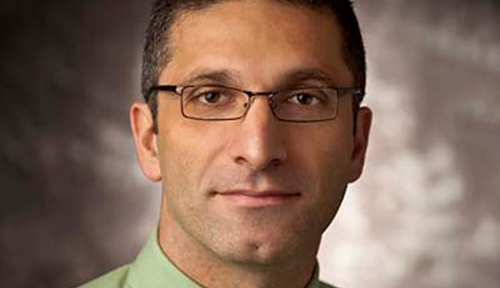EMBARGOED FOR RELEASE AT 5:30 P.M. (CDT), MONDAY, JULY 16, 2012
A study conducted by a University of Nebraska Medical Center infectious disease specialist makes a case for a potentially life-saving drug that was taken off the market last year by the drug company that produced it.
Andre Kalil, M.D., associate professor in the UNMC Department of Internal Medicine, studied a non-antibiotic drug known as Xigris (drotrecogin alfa – activated). The drug, which was taken off the market in 2011 over concerns of its efficacy by its manufacturer, Eli Lilly, was used to treat sepsis, a deadly blood infection that results in death in one-third of patients.
In his study, which is published in the July 17 edition of the prestigious British journal, The Lancet Infectious Diseases, Dr. Kalil studied nearly 50,000 patients who had taken the drug between 2001 and 2011. He found that the drug reduced the risk of death by 18 percent in these patients, which came from nine different countries. Dr. Steven LaRosa of Beverly Hospital in Massachusetts was Dr. Kalil’s co-author on the study.
The results of the study raise the question if the drug should be put back on the market, as physicians are desperate to find a more effective way to treat sepsis. Currently, antibiotics are the only and most effective drug treatment for sepsis. But even with antibiotics and good medical care, still one-third of patients die.
In the United States, close to 1 million adults and children get sepsis every year. About 300,000 die. Dr. Kalil said as many people die yearly from severe sepsis as do from heart attacks.
Xigris regulates the body’s inflammatory response to the infection, so that the harmful effect of the response, which is sepsis, is minimized.
The focus of the study was to determine how the drug performed in patients with severe sepsis 10 years after it first went on the market. “I wanted to know how the drug fared in the real world,” Dr. Kalil said. “Sometimes after drugs are approved, they don’t always perform like they did in clinical studies.”
The results surprised him.
“I was skeptical of the drug’s portrayed benefits in the real-world clinical practice,” he said, “but I had a feeling the drug worked in the most severe patients.” Because of the potential side effect of bleeding and the larger benefits observed in the sickest patients, Dr. Kalil said the drug only was used in the most serious sepsis patients.
After it was pulled off the market last year, Dr. Kalil said the key issues left unresolved were how widespread the drug should be administered and if survival benefits were indeed occurring.
During the 10 years the drug was being used, some studies raised questions of the drug’s efficacy and the side effects in patients with less severe forms of sepsis. The FDA requested Eli Lilly to conduct a second clinical study called PROWESS-SHOCK. This study didn’t show the same benefits found in the original study called PROWESS.
Eli Lilly withdrew the drug from the market last October, and the FDA sent out a safety announcement stating that treatment with the drug should be stopped.
Dr. Kalil’s study, which began in 2010 – one year before the drug was pulled from the market – determined that Xigris produced an 18 percent increase in survival in real-life clinical settings, which means that 18 percent of those who would otherwise die from sepsis could potentially be saved. The results were quite similar to the drug’s first clinical trial.
“Even though the company has removed the drug from the market, we should take these results seriously, considering the fact we studied close to 50,000 patients from nine different countries,” Dr. Kalil said. “There’s no other drug for sepsis that works in this way. It’s the only non-antibiotic drug that has been used in the clinical setting to treat patients with severe sepsis.”
Dr. Kalil said Eli Lilly’s second study, PROWESS-SHOCK cannot be compared to the first study, PROWESS. Because of this, results from PROWESS cannot be confirmed or refuted based on the second study.
“Now we’re left hanging,” he said. “It’s fair to say that the science on this drug is inconclusive. The survival benefits found with our new study bring back the question about the clinical utility of the drug.”
Dr. Jean-Louis Vincent of Erasme Hospital, Université Libre de Bruxelles, Brussels, Belgium, an expert in the field who’s been involved in most sepsis trials around the world, published a comment in The Lancet accompanying Dr. Kalil’s study.
“The death rate from sepsis is unacceptable and new drugs are needed urgently, so one might ask whether drotrecogin alfa (activated) can be resurrected,” wrote Dr. Vincent. “However, unfortunately Eli Lilly has given up and the drug cannot be produced easily.”
WHAT IS SEPSIS?
Sepsis, a common infection, is the body’s severe response to a bacterial infection in the body, including in the bloodstream, bones and organs. Having pneumonia is the most common way a sepsis infection starts.
Sepsis also can develop from common conditions, such as a skin infection, urinary tract infection, appendicitis rupture, meningitis, or after giving birth.
Through world-class research and patient care, UNMC generates breakthroughs that make life better for people throughout Nebraska and beyond. Its education programs train more health professionals than any other institution in the state. Learn more at unmc.edu.
